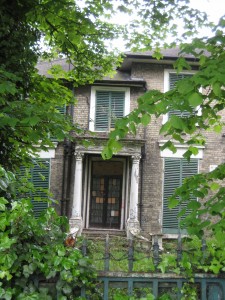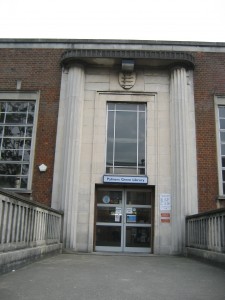Palmers Green Bus Garage
If you think that nothing about Palmers Green has ever been cutting edge, then think again. Or perhaps not.
In October 1910 John C Hill, a speculative builder who had been responsible for much of the development of the Bowers Manor Estate, opened a vast hall to cater for the craze of the age – roller skating. On the opening day, 700 people thronged to whizz round on the maple floor, to the accompaniment of a military band. Unfortunately Hill had opened his new amenity just a little too late. After a rousing start, visitor numbers quickly fell off a cliff and by 1912 the building was sold to the London Omnibus Company. It is now the home of rather more enduring wheeled transport in the form of Arriva buses.
In 2004 Maurice Cullum, Mike Wormall, Ted Simpson Arriva employees at the garage, decided to research the history of the bus garage further. The result was a 140 page history of the building and of London buses in the area.
http://www.arrivalondon.com/news_archive/45/slug:Employees-research-garage-history
The Pound
Apart from Clappers Green footpath, the pound is the only reminder of the rural character of the lands of the estate immediately south of Bourne Hill. The pound was operated by a pinder, who looked after stray animals for a fee. According to Dumayne, the last inhabitants, in 1904, were a pig and some horses belonging to travellers.
The Cock forge
As befits its former rural status, Palmers Green was once home to a number of forges. Ordnance survey maps show that there was one next to Hazelwood House on Green Lanes and another opposite the Cock Inn on what is now the corner of the North Circular Road and Green Lanes.
The Cock forge was another neighbouring forge. Owned by the Mackintoshes, the forge was, says Alan Dumayne, next to the pub to the south, literally in the middle of what is the present day North Circular Road. After it was demolished in 1906, the McIntosh’s moved their business to 381 North Circular Road and operated there until 1965. The building, with its old weather vane, is still there.
The weather vane is, however, much much older. It comes from the Weld chapel, built in 1615, and demolished in 1862 to make way for Christ Church, Southgate.
Truro House

Currently in a sorry, boarded up state, and by all appearances also squatted, Truro house is one of the few Victorian buildings in Palmers Green, the other two obvious survivals being the station and the former Cock Inn (now a supermarket).
It stands of the site of the Kings Arms Inn, which, demolished according to Alan Dumayne in the 1850s, next became a nursery, one of several on Green Lanes. Truro House appears to have been built sometime in the 1860s or thereabouts and to have taken its name from Lord Truro of Bowes Manor, who was created a peer in 1850.
Deadman’s bridge
Just south of central Palmers Green, as Green Lanes approaches the North Circular, are two bridges, the first crossing Green Lanes, and the second crossing Pymmes Brook, and going by the name Deadman’s Bridge.
Why it is called that we do not seem to know, but the name appears to be ancient. A History of the County of Middlesex vol 5 (www/british-history.ac.uk) states that in the sixteenth century Green Lanes was a collection of linked roads, one of them being Deadman’s Hill in Palmers Green. In 1789 they find a reference to “Bowes Farm Bridge, presumably Deadman’s bridge in Green Lanes” where “a single arch, was built…by the road trustees and repaired in 1822 by the county”. Presumably the 1789 bridge replaced an earlier structure, (given that Pymmes Brook always needed to be traversed by those heading north). Presumably too the present bridge is in part or wholly another post 1822 incarnation. It would be interesting to know.
Another mystery is what occasioned the warning to traction engines and carriages which is posted on the bridge on a metal plaque (the wording is slightly unclear – the decifering below is by photographer Fin Fahey)
‘COUNTY OF MIDDLESEX / TAKE NOTICE that this Bridge / which is a County Bridge is insufficient to carry / weights beyond the [ordinary?] traffic of the / District and that the owners and persons in / charge of LOCOMOTIVE TRACTION ENGINES / and heavily laden CARRIAGES are warned / against using the Bridge for the passage of / any such Engines or Carriages / Richd. Nicholson / Clerk of the Peace.’
The Library

While Germany was burning books, we were opening libraries. The Palmers Green Library was opened in 1940 behind Southgate Town Hall. Stark and practical in style, it is handsome in its own way. Note to Enfield Council – we would like to keep it please.